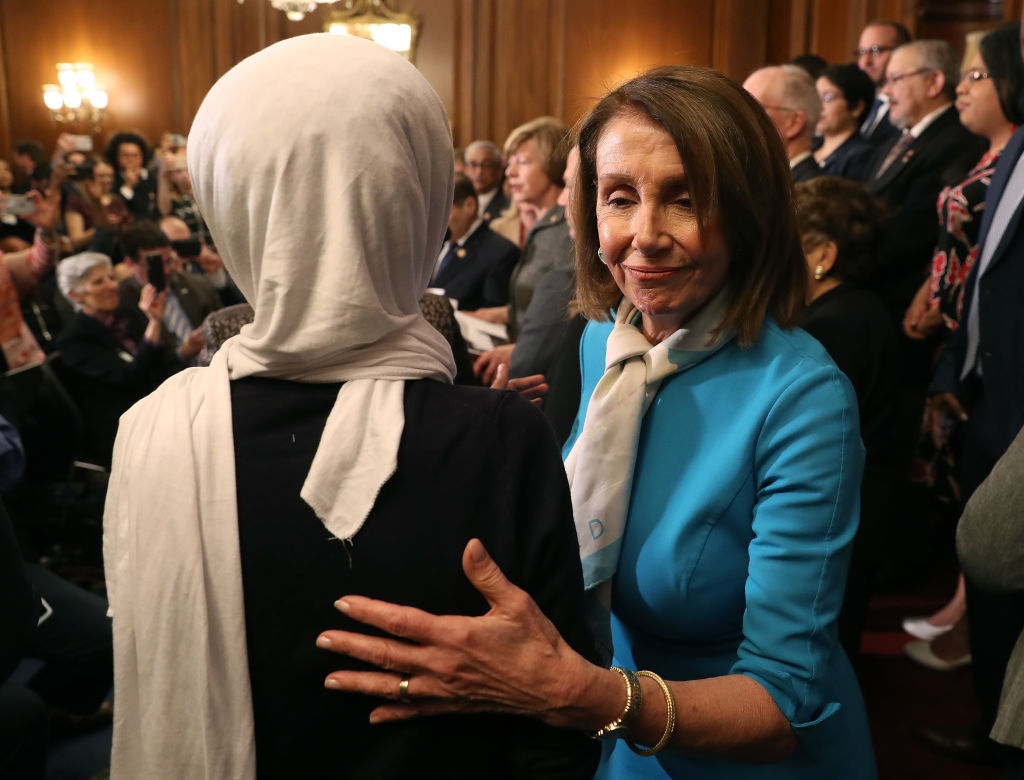The Democratic Party Is a Contradiction
The Democratic Party isn’t a coalition — it’s a contradiction. And thanks to the conflict between Alexandria Ocasio-Cortez and her fellow progressive House members and Nancy Pelosi, that contradiction, between a restive base demanding radical change and a hidebound leadership bent on moderation, is now visible for all to see.

House Speaker Nancy Pelosi (D-CA) walks by Rep. Ilhan Omar (D-MN) during a news conference where House and Senate Democrats introduced the Equality Act of 2019, on March 13, 2019 in Washington, D.C. Mark Wilson / Getty
This past week has reaffirmed much about the basic dynamic of American politics that has prevailed since 2016.
Despite a near-perpetual onslaught from a rabidly right-wing Republican president, the leadership of the official opposition remains unable and unwilling to launch a full-throated counterattack — resorting instead to the same cliches about decorum and moderation that have become its bread and butter. As in 2016, however, this purgatory faces a challenge from both an energized left and a restless section of the Democratic base who longer wish to follow a tepid script set down by the likes of Nancy Pelosi and Chuck Schumer. And, then as now, party elites often exhibit more zeal and display greater coherence in opposing this challenge than they do in opposing the Republican Party.
To wit: the chain of events which last night culminated in a fascistic display from Donald Trump and his supporters in Greenville was initially set in motion when the Democratic leadership opted to publicly admonish several of the party’s own members. Despite demanding message discipline from her caucus, House Leader Pelosi patronizingly dismissed left-wing representatives Rashida Tlaib, Ayanna Pressley, Alexandria Ocasio-Cortez, and Ilhan Omar in an interview with the New York Times’ Maureen Dowd. Their infraction? Exhibiting moral outrage towards the administration’s grotesque border policies and voting against a leadership-backed appropriations bill that included funding for them.
Trump’s grotesque attacks, which began with a series of racist tweets last weekend and crescendoed last night in North Carolina, are already helping obscure this all from memory: with the president now involved, Pelosi effectively had no choice but to turn her fire in the other direction. As the Huffington Post’s Zach Carter so aptly described it:
Divided over how to oppose Trump and his agenda, party leadership attempted to purge its own ranks, and only eased up when the president himself attacked the same members that leadership had been blasting for weeks.
Fittingly enough, even the ensuing Democratic censure of the president managed to invoke Ronald Reagan and was quickly watered down by Pelosi herself.
Needless to say, this momentary pause in hostilities will do nothing to alter the underlying dynamic at play. Because, aside from the specific details of disputes about border funding, electoral strategy, campaign financing, or foreign policy, the conflict ultimately reflects a clash between radically different visions; visions disorientingly contained within the same party structure thanks to the absurdities and dysfunction of America’s embedded political duopoly.
Since the Clintonite counterrevolution of the 1990s, the liberal side of this duopoly has been dominated by the interests and thinking of white-collar professionals: its leadership pledging fealty to markets and corporate actors and eschewing the language of populist contestation in favor of elite bipartisanship and management-speak — the solipsistic pablum of the Chamber of Commerce or company boardroom with a dash of social liberalism thrown in for branding’s sake. Nevertheless, a significant portion of the working class still votes Democrat and a considerable constituency of Americans sits decidedly to the left of its leadership on many key issues.
It’s an arrangement that has tended to serve the leadership pretty well, provided the base never grows too vocal, restless, stringent in its demands, or lacking in deference towards those at the top. But progressive lawmakers boosted by activists, funded by small donations, and resolutely seeking change on a larger scale threaten to unbalance the whole scheme: a one-sided compromise wherein party leaders perform the liturgy of reform-minded opposition while maintaining a status quo in which the interests and money of corporate actors and interests groups largely determines the overall agenda.
At its root, then, the Democratic Party is more a contradiction than a coalition: a giant, lumbering political machine piloted by centrists and undergirded by corporate money, yet paradoxically the default vehicle for opposition to an increasingly feral and reactionary right.
By openly challenging the leadership, the activist left and its new tribunes in the House have rendered that contradiction — and the stifling constraints it imposes on the opposition — visible for all to see.